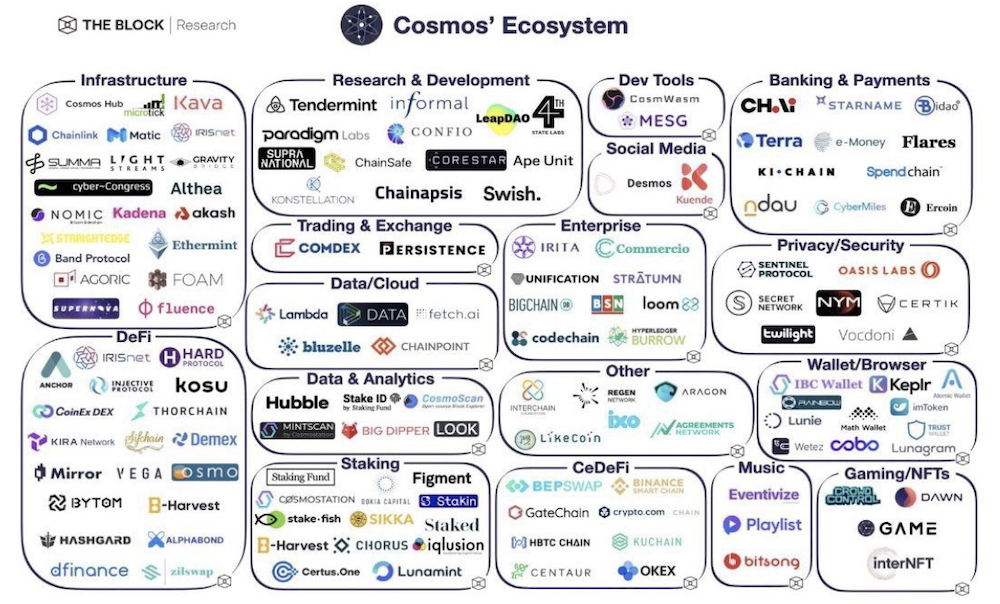Over the past few months, the Cosmos ecosystem (native $ATOM), has garnered significant attention from the cryptocurrency world, boosting it to #16 on the market cap ranking.
Cosmos ($ATOM) was founded in 2014 by crypto OGs, Jae Kwon, Zarko Milosevic and Ethan Buchman. Despite being an OG project then, Cosmos has gained relatively strong traction from the new retail market with its listings on popular exchanges like Coinbase.

Cosmos touts itself as a project that tackles some of the blockchain industry’s most pressing issues. It is a protocol that facilitates “blockchain interoperability,” or the ability for multiple blockchains to connect.
Cosmos intends to connect several crypto networks using open-source technologies that enable cross-chain transactions.
Unlike the past, we now have many more chains with dApps built on it as compared to 2017 where ETH was the only operational chain. The importance of interoperability is seen as a “need” for this space and strongly regarded among supporters of $ATOM.

Cosmos’s ICO on 5th April 2017 had a massive boost of 375.6x from ICO price. This year alone sees $ATOM having a run up of about 8x at time of writing.
It should be interesting to note that there has been strong $ATOM supporters who put together community run resources that would benefit the larger community.
An example would be the circulating list of airdrops for ATOM holders/stakers and Cosmos ecosystem created by CryptoAlexand which may be useful to check if you qualify for any airdrops — and how you could potentially win some in future.
Competitors to Cosmos

From the above, the Cosmos is the only working chain that offers interoperability, with 800,000 transactions this month as compared to counterparts like polkadot and wanchain.
Cosmos is laying the groundwork for a globally linked token economy. Cosmos includes a communication protocol (IBC protocol), a consensus engine (Tendermint Core), and a software development kit (Cosmos SDK) for creating customized blockchains to make this possible.
New blockchain applications can be created at incredulous speed using these technologies, linking and exchanging data and assets for the first time in history. With Cosmos, Blockchain technology can revolutionize decentralized finance, prediction markets, cross-border payments, healthcare, real estate, and other industries.
Proof of Stake – Tendermint Core
Tendermint blockchains are considered to be some of the most secure and scalable in cryptocurrency.
They can handle up to 10,000 transactions per second and continue to operate even if one-third of validator nodes are offline or trying to corrupt the network.
Besides that, Tendermint makes it possible to create customizable, secure, and scalable blockchains from the ground up in weeks instead of years.
The trade-off is that Tendermint chains have limits on the number of validators they can support. The current validation limit for the Cosmos blockchain is just 125, which is relatively centralized for a cryptocurrency.

$ATOM coin powers the Cosmos Hub proof-of-stake blockchain. The Cosmos currency is a crucial component of the Cosmos network’s blockchain interoperability. Users can earn ATOM tokens and contribute to the security of the Cosmos Hub by using a hybrid proof-of-stake mechanism. $ATOM also contributes to the network’s governance.
In a nutshell, Cosmo aims to offer a solution where the chain would be a natural option against slow, unscalable, expensive protocols.
On top of that, Cosmos offers the ability for different blockchains with different codes to use their software development kit to build on their infrastructure to communicate easily between one another.
What is Cosmos IBC (Internet of Blockchain)?
IBC is one of the most significant milestones for cryptocurrency space. This is because any cryptocurrency blockchain can theoretically connect to the IBC.
IBC already supports all substrate-based blockchains, such as PolkaDot (DOT) and Kusama (KSM). Any proof of stake blockchains can connect to Cosmos Hub, and the interoperability process is similar to wrapped tokens on Ethereum.
Cosmos Hub has voted to add the Gravity Dex as the next upgrade as well. Gravity Dex will act as a marketplace for trading tokens from any connected blockchain, including tokens from IBC-enabled blockchains, wrapped ETH and ERC20 tokens, wrapped BTC tokens, and any future networks that implement IBC.
Cosmos SDK
Cosmos SDK is the world’s most popular framework for building application-specific blockchains. In the Cosmos ecosystem, each application has its own blockchain and retains its sovereignty, as opposed to Ethereum for example, where all applications are built on top of the same blockchain and submit to that blockchain’s rules.
Atom’s Ecosystem

To date, Cosmo has gotten tons of projects onboard their ecosystem. The core projects of the ecosystem are already present, such as RUNE; cross-chain AMM, rolling out cross-chain products in the latter part of the year as well as Chainlink; a price oracle. Cosmo has all the fundamentals in place for the ecosystem to take off and fly.
As more L1 chains with dApps are developed in this space, it will be exciting to see how Cosmos’ ability to allow blockchain interoperability will further develop cryptocurrency as a whole and connect the different networks.
Featured Image Credit: Investor Place
Also Read: Raydium: The Heart Of Solana And Go-To Place For Trading Solana DeFi Tokens



































